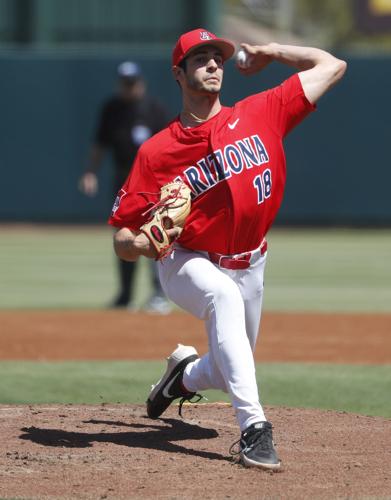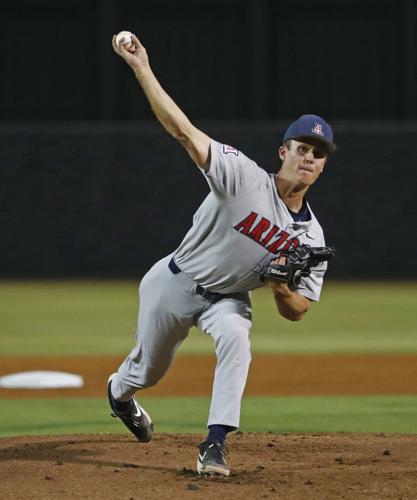Arizona’s relentless, prolific offense has drawn the most attention, and rightfully so. The Wildcats are averaging 13.3 runs in 11 games this month. They have won 10 of them.
But the most encouraging sign for Arizona – which suddenly has a realistic chance to sneak into the NCAA Tournament – is that its pitching has improved.
UA starters Randy Labaut, Andrew Nardi and Quinn Flanagan were stellar during the team’s three-game sweep at Penn State over the weekend. They combined to allow one earned run in 19 1/3 innings. Their ERA was 0.47. Their WHIP was 0.98.
Those numbers would be notable on any squad in the country. For the Wildcats – who have struggled from the mound for most of the season – they’re indicative of a titanic turnaround.
“All they have to be is OK, and it’s going to be good enough to win,” UA coach Jay Johnson said. “This (past) weekend, those three guys were really good.”
They actually have been trending in that direction for a while.
Labaut’s ERA sat at 6.82 after he allowed six runs in 6 2/3 innings at Arizona State on March 29. He has a 4.12 ERA since with five quality starts in seven outings. He also has five wins over that span, including the past four series openers.
Nardi surrendered five runs in the first inning against Oregon on May 4. Since then, he has allowed two earned runs in 15 frames, good for an ERA of 1.20.
After failing to get out of the first inning against New Mexico State on April 30, Flanagan has yielded two earned runs in 15 1/3 innings. That’s an ERA of 1.17.
What’s changed? Johnson, whose team closes the regular season at Washington State Thursday-Saturday, cited two factors.
“We’re getting ahead, to where we’re a little less predictable,” he said. “There’s a lot more 1-2 counts as opposed to 2-1 counts.
“And then, most significantly, the ability to change speeds. It’s two weeks in a row where Flanagan and Nardi have really commanded their changeup and have really kept people off balance.”
Because the starters were able to go deep – and the offense staked Arizona to a sizable lead in each game – the bullpen didn’t face many high-leverage situations against Penn State. Aside from closer Vince Vannelle, that aspect of the team remains a concern.
Vannelle did not allow a run in two appearances against the Nittany Lions. The rest of the bullpen yielded nine earned runs in 5 2/3 innings.
“Not very good, period,” Johnson said. “Vince picked us up, but the other guys struggled.”
In Game 1 of the series, Vannelle entered with the bases loaded and one out in the seventh inning. Arizona led 6-1 at the time. Vannelle threw one pitch that resulted in an inning-ending double play.
In Game 3, the junior right-hander again succeeded in putting out a fire. Penn State had cut its deficit to 9-4 in the bottom of the eighth and had runners on first and third with two outs. Vannelle walked the first two batters he faced, allowing one run to score (charged to Avery Weems). But he retired four of the final five to finish the game and complete the sweep.
Postseason push
A 5-0 week, which started with a doubleheader sweep of Sam Houston State, extended Arizona’s winning streak to seven games and elevated its RPI to 45. It hasn’t been this high since February.
After a frustrating 2½ months that tested Johnson’s patience, the Wildcats have put themselves on the NCAA Selection Committee’s radar.
“I feel like, as of this moment, we’re there,” Johnson said. “But there are more factors that are out of our control.”
To make the NCAA Tournament — an inconceivable idea less than a month ago — a few things need to happen.
First, Arizona (29-24, 12-14 Pac-12) must sweep Washington State (11-39-1, 3-23-1). The Wildcats had a better résumé a year ago but didn’t make the tournament, in large part because of their 14-16 conference record. A sweep of the Cougars would put the Cats at 15-14.
Second, Arizona could use some good fortune. The fewer upsets that occur in conference tournaments, the better. When one-bid leagues turn into two-bid leagues, it’s bad news for teams on the bubble.
Finally, Arizona must hope that a strong finish will outweigh a rocky start when the committee considers its case.
“I hope they’re paying attention,” Johnson said. “I have a hard time believing anyone in the country is playing better right now. There’s probably some teams playing equal, or a different kind of better, but we’re hot.
“We dug ourselves a hole in a tough year in the Pac-12, where there’s a lot of older teams. We’re not an older team. We caught all those older teams on the road, all four of them, in a six-week stretch. (Arizona went 1-11 against UCLA, Arizona State, Oregon State and Stanford between March 22 and April 28.) We weren’t as good as we needed to be at that point.
“But I feel like we got through that. I feel like guys are improving.”
The official NCAA Tournament field of 64 will be revealed this upcoming Monday.
Inside pitch
- UA junior third baseman Nick Quintana has a 12-game hitting streak. He’s batting .473 during that stretch with four home runs, nine doubles and 26 RBIs. He leads the Pac-12 with 72 RBIs, 11 more than second-place Hunter Bishop of ASU.
- Junior shortstop Cameron Cannon leads the nation with 29 doubles, which is one shy of the school record shared by Dave Stegman (1976) and JJ Matijevic (2017). Cannon has two or more hits in 10 of his past 12 games and has lifted his batting average to .390.
- Catcher Austin Wells has 67 runs and 52 RBIs, becoming the first UA freshman to notch at least 50 in both categories since Keoni De Renne in 1998.
- Freshman infielder Dayton Dooney had three home runs last week to give him nine for the season. He had five in his career at Poway (Calif.) High School.






